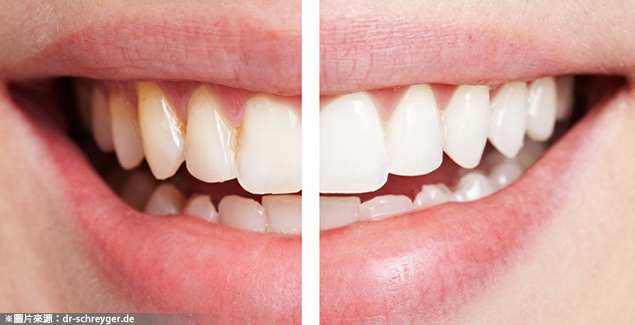
文/Dr. Phoebe

As mentioned from the previous article, it is imperative that we first understand why our teeth are discolored, prior to determine bleaching options. Bleaching improves teeth discoloration in 90% of the patients, and is best fit for those with yellow discoloration. In this article, we will now discuss the four different types of teeth whitening or teeth bleaching.
1.Over the counter bleaching products
These are the most commonly seen bleaching materials, as you can probably see them laying around in the pharmacy or drug store. They usually come with a package of bleaching materials plus a standard sized tray. Most of them contains around 3.5% of hydrogen peroxide, while others contain carbamide peroxide. Hydrogen peroxide is the main component that gives the whitening effect to the teeth. It is generally not advised for the patient to purchase or utilize these OTC materials without first consulting with his or her dentist, as some patients do have adverse reactions or sensitivity from utilizing these products.
Furthermore, most of these OTC bleaching trays are “one size fits all.” Others may have a piece of moldable plastic that molds differently through high temperature. Regardless, it is challenging to contain all the bleaching material and for the teeth to effectively absorb the bleaching material.
2. In office bleaching
Most of the bleaching material in the office contains 15%-38% of hydrogen peroxide. After the consultation visit with your dentist, you will return with a bleaching appointment, and walk away with a whiter smile. The dentist will first record your “before” shade as a reference, and will then place materials as to isolate your gum, tongue, cheek, etc. Once everything is set, the dentist will then place bleaching material on your teeth, sometimes with the aid of light, and others without. It is usually performed in a fifteen minute interval per “bleaching cycle,” where four cycles are a maximum a patient can receive that day. An “after” shade will then be recorded.
This method has the most significant outcome in the shortest period of time. However, the sensitivity for the in office bleaching tends to be more prominent due to the higher percentage of hydrogen peroxide, and the color also fades a few shades back more quickly than the take home customized tray bleaching method.
3.Take home customized tray bleaching
If you are not in a hurry, or if you are petrified with post bleaching sensitivity, you may want to consider the take home customized tray bleaching method. The hydrogen peroxide content tends to be between 3% to 15%, hence the less likelihood of sensitivity. The dentist will first take a mold (or impression) of your teeth, and using that mold, to create customized bleaching trays for you. The dentist will then give you the take home bleaching material, as well as the instructions. With the take home bleaching material, there should be significant improvement on the color of the shade in three days to six weeks, yet for nicotine product users it may take up to two months for significant results to be demonstrated. The resulting whiter shade tends not to fade as quickly as the in office bleaching method.
4.Give me both?
For the most optimal esthetics effect, dentists may recommend the patient to start off with the in office bleaching, and using the take home bleaching kit as a “maintenance” method when the color starts to fade. This ensures long lasting bleaching effect for the patient. Regardless with the type of method, a patient will be recommended to be in a “colorless” diet while having bleaching, in order to create the maximum outcome of the result.
-Supplemental material from ADA website:
http://goo.gl/fUu5J8


Polygon recent comments